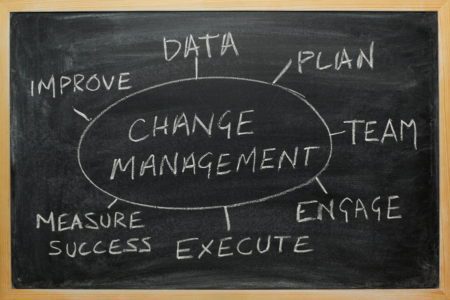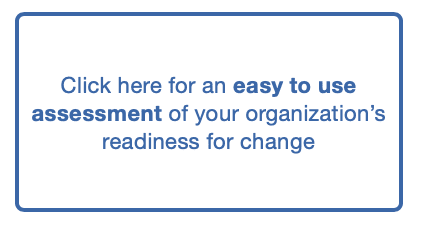According to a study by Boston Consulting Group, 85% of companies have undertaken a transformation during the past decade. Related research found that nearly 75% of those transformations fail.
What Are You Doing to Increase Your Chances for Success?
Constantly changing market conditions and customer demands continually challenge how we do our jobs. With this, the need for agile work environments that can adapt quickly to change continues to grow in importance, yet as noted above, 75% of those transformations fail.
Research shows that businesses that facilitate a thorough organizational change management plan have a much better chance of weathering the storm and succeeding in mass adoption of the change.
In order to thrive in these dynamic times, we need to lead our organizations through change in a proper manner. In this blog, we will discuss what Organizational Change Management is, when to use it, and how to plan for it.
What is Organizational Change Management (OCM)?
Organizational Change Management (defined below) is a concept and an activity that has been around for years. Oddly, it still struggles to gain priority status with many organizational leaders.
When going through a period of change, Leadership can be so focused on the tactical side of going through the change (“turning the wrenches”) that they completely forget about the people who will be turning the wrenches once this change has been implemented.
This oversight is understandable, especially since leadership bandwidth, competing priorities and so many activities can get in the way of managing change. However, the risk of failure becomes greater the more people that are involved and impacted by the project or initiative.
This can lead to poor adoption and execution of the change.
To understand when to develop and execute an Organizational Change Management Plan, let’s first define Organizational Change Management. One definition, by the United States Government Accountability Office has a very solid and comprehensive definition:
Change Management: activities involved in:
(1) defining and instilling new values, attitudes, norms, and behaviors within an organization that support new ways of doing work and overcome resistance to change;
(2) building consensus among customers and stakeholders on specific changes designed to better meet their needs; and
(3) planning, testing, and implementing all aspects of the transition from one organizational structure or business process to another.
So what’s the takeaway? When making change in your organization, the people experiencing the change need to be guided through this transition in a thoughtful and structured manner.
But when should this be done? How does someone quantify or identify, when going through the additional time and effort is necessary to build and execute a Change Management Plan?

The Top 4 Indicators To Help You Know Whether You Need a “Real” Change Management Plan
Here are four conditions to help you recognize when you need a Change Management Plan:
1) More than 20 people (give or take a few) are involved and will need to change what they do for a critical job function.
When working in a small team (under 20 people and, say in a single location), and the change is isolated to only that team or department, it’s easy to call a quick huddle, a meeting, or just lean back and say “hey, we’re going to change this. OK?”
However, when you have more than 20 people, this approach becomes increasingly more difficult because people get tired and experience change fatigue.
In our experience, when you need to involve more than 20 people, or those 20+ people are scattered across a few departments and/or locations, you will need to begin to add some structure to it. For example, let’s say that you are changing how you process product returns, which involves:
-
- 15 people in customer service,
- 10 people in the warehouse and
- 5 people in credit and billing
This may likely need a light Change Management Plan that maps out the impact to these teams and how you may address the change via training, documented procedures, performance metrics, etc.
Imagine if there are 2x (or more) the number of processes, people, and departments involved. Now you are getting into the need for a structured Change Management Plan with a dedicated person(s) to drive its execution.
2) Multiple departments/work groups are involved in executing the change.
Change that involves more than one department, as a general rule will need a structured Change Management Plan. The implication is that when executing a change across departments or work groups, process and role changes are occurring. This may also impact compensation plans (both individual and group) and, if you are in a regulated industry, it can become even more complicated.
A critical error many organizations make during change is not effectively communicating and educating staff who need to work across department lines how that handoff/transaction will be changing.
This leads to miscommunications, inaccurate or incomplete information, and an endless stream of conflict between groups. With a Change Management Plan that has been developed and executed effectively, teams may actually work better, internally and across departments than before as a result of understanding how they impact other members of the organization who depend on their work.
3) There is “significant change” in terms of how people do their work.
Being somewhat subjective, my measure of “significant” in this context is when a group of people will be changing around 30% of their daily activity (measured by hours spent, e.g., 12 hours in a 40-hour work week are different) by changing their process, learning and using a new system, device or other tool.
Some may argue that this number could be significantly higher or lower. 30% is based upon my experience where people really start having negative reactions if they are told to just do it without proper guidance or communication.
A change of this magnitude is stressful and difficult to do, let alone without support. A Change Management Plan would provide a roadmap to help these people move forward, minimizing the fear of the unknown hindering their progress.
4) Cultural resistance has already been witnessed and felt.
This is the one condition that does not have a number associated with it. Often, project leaders will understand very early on how impactful this change will be. They will be leery of how their organization will accept this change because there is already felt resistance.
This culture of resistance to change is commonly based on the success and adoption (or lack thereof) of past changes, blatant and at times aggressive  resistance to change, and other signs that the organization may strongly resist change. Part of a well-developed Change Management Plan is clearly identifying and strategizing for the organization’s readiness for change.
resistance to change, and other signs that the organization may strongly resist change. Part of a well-developed Change Management Plan is clearly identifying and strategizing for the organization’s readiness for change.
What this means is that depending on the priority level of the project, the project may need to be delayed, or different Organizational Change Management tactics will need to be utilized to move the organization and its people through this change.
Going through change is hard, but it does not need to be overwhelming. Change, by no means, is impossible.
The first step to ensuring that change will be adopted with the least amount of productivity loss over the shortest amount of time is to understand whether a Change Management Plan needs to be developed and executed.
Final Thoughts
When a change management plan is being executed, resist the temptation to move time and resources that are allocated for change management to finish operational go-live tasks or to simply be forgotten in the rush to complete the project.
Too often I have seen project delays and other project issues push change management off to the side. Often this is due to leaders viewing change management activities as a lower priority.
However, even if change management is pushed to the side, the projects will be completed, on time, and possibly in full, but rarely without errors due to poor adoption of the change.
Those errors will cause additional costs to manage ongoing resistance to change, as well as the time-consuming correction of transactions and data due to people not using the system or processes as intended. If leaders want projects to be delivered in the least disruptive and most cost-effective manner, then OCM needs to be viewed with the same criticality as requiring that all employees have the proper tools and facilities with which to perform their jobs.
Using the conditions above to identify when a change management plan is needed, and executing it as needed without constraints will put your organization in the best possible position to transition through the change as painless as possible.
Want to learn more about how TSI can help your organization through a time of transition? Read more about how TSI approaches OCM by going here or contact us directly at TSI@transforming.com or call us at (847) 705-0960 x 202.
Reading List
Here are a few items we have been reading and using as research for this and other efforts.
Cross-Silo Leadership – Casciaro (et al.) from Harvard discusses four practices that enable effective interface work through horizontal collaboration.
Leaders Focus Too Much on Changing Policies, and Not Enough on Changing Minds – Tony Schwartz (HBR) discusses how businesses overlook the “internal shift” during change.
A Leader’s Guide to “Always-On” Transformation. – Unprecedented disruption is challenging established business models, and is requiring organizations to launch more frequent transformations in response.
Why Doing The Easy Parts Of Your To-Do List First Can Be A Bad Idea – The essence of the article is that most of our greatest learning comes from doing difficult tasks, so choosing easy tasks does not necessarily benefit us.
Leadership Needs to Neutralise Innovation Blockers – And Here’s How – Scott Anthony’s (Top 10 global business thinkers in the prestigious Thinkers50 listing) research shows that the most innovative companies display five key behaviors.
Why Customer-First Companies Ultimately Win – Kyle Tibbits discusses how companies have lost touch with customers.
